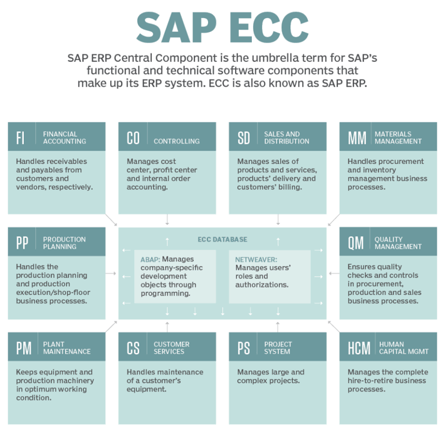SAP’s vision is S4/HANA and C4/HANA as a way to provide accelerating business change, manage data and more closely integrate together enterprise applications, business processes and clouds.
I continue to meet really impressive, highly experienced IT professionals who are new to the world of SAP.
For me this represents a great addition to our world at a time when accelerating change and doing things differently is paramount. That's why I'm going to give an overview of the basics in this SAP 101.
Let’s start with the SAP foundations
In this first blog, I thought I would start with the foundational knowledge of SAP to get the building blocks defined. There are three areas in the basics of SAP: database or databases, applications (SAP refers to these as Components) and finally there are processes and interfaces.
SAP stores information in the database. Applications access this via NetWeaver and ABAP which have been developed with specific processes to deliver defined outcomes. There can also be customer specific processes and interfaces which link SAP and non-SAP systems together to work in any organisation. It is important to recognise that implementing SAP ECC is a large project for any business. Changing and upgrading these over time is incredibly complex, whilst simplifying such complexities to work in a more agile way can initially appear daunting.
SAP data can be stored in the database which can be Oracle, Microsoft SQL, IBM DB2, Sybase, MySQL and SAP HANA (the In-memory version). The problem we face is that SAP has to collate, manage, process and report on an increasing amount of data, as well as increasingly in real time or at low latency business requirements.
Most companies are seeking to have a complete customer perspective or omni-channel experience across all platforms in which they interact with customers (Internet client, mobile application, In-store). They are also wanting to attract and influence on a wide variety of platforms and formats. Most databases have been relational and structured and have served SAP applications well. The majority of organisations now process increasing volumes of unstructured customer data in real time and need to provide a holistic experience closely integrated to fulfillment.
Customer-centred SAP service
The aim is to deliver the very best user and customer experience. To address the increasing amounts of data with increased demand for real time analysis and processing, SAP launched the HANA (In-memory database) version in 2010. In-memory databases are much faster and store data differently to address previous limitations in delivering an enhanced real time user experience.
However, to maximise the benefits of a faster database, it is also necessary to update SAP components (applications) accessing the data and corresponding SAP business processes. The core SAP ERP application is known as ECC (ERP Central Component) and it is the first component of the SAP business suite. In total there are ten core components and two technical components in ECC, including the Customer Relationship Management system (SAP CRM), the Supply Chain Management system (SAP SCM) and Sales & Distribution (SAP SD).

Source: TechTarget 2018
There are SAP functional components which support more industry specific requirements. Each component must be purchased, licensed, implemented and integrated to maximise the capabilities, analytics and process flows in any organisation. Two mandatory technical components are NetWeaver (providing SAP ECC system administration capabilities including user security, roles and authorisations) and ABAP (Advanced Business Application Programming) which is the default programming language for SAP components.
SAP services optimised for specific circumstances
The third area of focus is business processes and integration. Inevitably over time, business processes are updated and modified. New processes and systems are added. Processes to address gaps and interface requirements are updated while business requirements continue to evolve.
Newer SAP platforms such as SAP S/4HANA (which is the updated version of ECC) supports significantly greater levels of SAP component process automation and consolidation. This simplifies and accelerates data processing and analytics and ultimately the customer experience.
SAP 101 is just the beginning
So you've been given an overview of the basics of SAP. But this is just the start. With the right partner helping you make the right choices, SAP can transform your business. Contact us today to find out more.



